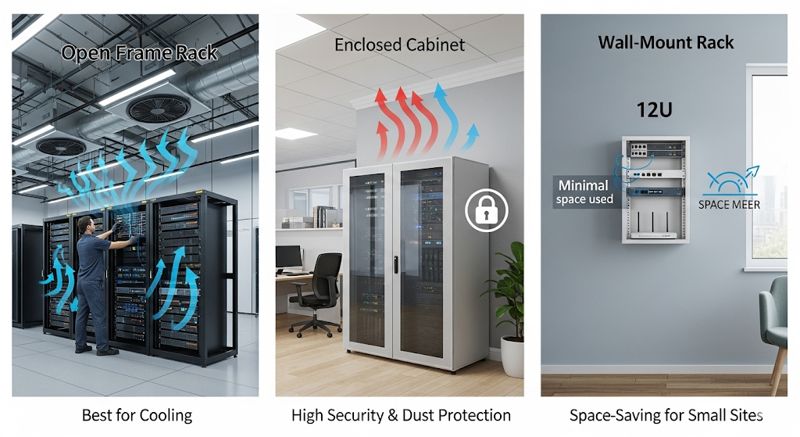Cable & Wire | High quality and excellent service at reasonable prices.
info@zion-communication.com
Author: Will Publish Time: 11-08-2025 Origin: Site
Server racks are the backbone of modern IT infrastructure, providing an organized framework for housing critical networking equipment. These specialized enclosures not only protect valuable hardware but also optimize space utilization and thermal management in data centers and server rooms.
A server rack is a standardized metal frame designed to securely mount and organize IT equipment including servers, switches, routers, and storage devices. Following the 19-inch EIA-310 standard, these racks provide a uniform mounting system for compatible hardware.
Equipment Organization: Centralizes and arranges multiple devices in a structured manner
Physical Protection: Shields sensitive equipment from dust, accidental damage, and unauthorized access
Thermal Management: Facilitates proper airflow to prevent overheating
Easy Maintenance: Provides convenient access for upgrades and troubleshooting
Feature / Parameter | Details |
Definition | A standardized frame or enclosure used to mount, organize, and secure IT/network equipment |
Standard Width | 19 inches (EIA-310 standard) |
Height Measurement | Rack Units (U), 1U = 1.75 inches (44.45 mm) |
Common Heights | 12U–24U (small setups), 42U (standard), 48U+ (large-scale) |
Types | Open Frame Rack, Enclosed Rack Cabinet, Wall-Mount Rack |
Materials | Steel, Aluminum |
Cooling Options | Natural airflow, built-in fans, hot/cold aisle configurations |
Cable Management | Cable trays, hooks, Velcro straps, rear organizers |
Security Features | Lockable doors, side panels, access control |
Power Options | PDUs (Power Distribution Units), UPS systems |
Best Use Cases | Data centers, enterprise networks, telecom rooms, server hosting |
Advantages | Organization, security, cooling efficiency, space saving, easy maintenance |
■ Server Rack Components & Operation
Mounting Rails: Vertical posts with standardized hole patterns (square or round) for securing equipment
Rack Units (U): Measurement system where 1U = 1.75 inches (44.45mm) of vertical space
Mounting Hardware: Includes cage nuts, screws, and rails for secure equipment installation
Cooling Systems: Ventilation openings, fans, or provisions for liquid cooling
Cable Management: Dedicated channels, hooks, and panels for organized routing
Power Distribution: Integrated PDUs (Power Distribution Units) for efficient power delivery
Security: Lockable doors and side panels to restrict access
No side panels or doors
Ideal for secure environments with existing cooling
Most cost-effective option
Full enclosure with front/rear doors and side panels
Enhanced security and dust protection
Better for office environments and data centers
Compact designs for space-constrained areas
Typically support lighter networking equipment
Perfect for small offices and network closets

Rack height is measured in rack units (U), with common sizes including:
6U-12U: Small network installations
18U-24U: Departmental server rooms
42U: Standard data center height
48U+: Enterprise-level deployments

Rack Height | Height in Inches | Height in mm | Suitable For |
6U | 10.5" | 266.7 mm | Small networking setups, branch offices |
12U | 21" | 533.4 mm | Small business server rooms |
24U | 42" | 1066.8 mm | Mid-sized IT infrastructure |
42U | 73.5" | 1866.9 mm | Standard data center rack |
48U | 84" | 2133.6 mm | High-density enterprise environments |
■ Key Benefits of Server Racks
Space Optimization: Vertical stacking maximizes floor space
Improved Cooling: Proper airflow extends equipment lifespan
Enhanced Security: Physical protection against tampering
Simplified Maintenance: Easy access for upgrades and repairs
Cable Organization: Reduces clutter and improves airflow
Place heavier equipment at the bottom for stability
Allow adequate clearance for airflow (front, back, and sides)
Implement proper cable management from the start
Implement hot aisle/cold aisle configurations
Consider blanking panels to prevent air recirculation
Monitor temperature at different rack levels
Leave 20-30% of space for future expansion
Label all equipment and cables clearly
Document rack layouts and configurations
Consider implementing a server rack if:
You manage multiple servers or network devices
Your IT infrastructure is growing
You need better equipment organization and security
Cooling and cable management are becoming issues
Server racks are fundamental components of efficient IT infrastructure, offering organization, protection, and thermal management for critical equipment. Whether you're outfitting a small network closet or a large data center, selecting the appropriate rack solution will pay dividends in reliability, maintenance efficiency, and long-term scalability.
A: Yes, as long as all components adhere to the 19-inch rack standard and U measurements, they can be mixed.
A: Capacity varies by model, but full-size racks typically support 1000-1500kg when properly anchored.
A: Perform visual inspections monthly and thorough cleaning every 3-6 months, depending on the environment.
Contact us for more information

Will is the Copper Cabling Product Manager at Zion Communication,
specializing in the development and marketing of Ethernet cabling solutions.
With extensive industry experience, he is dedicated to delivering high-performance
and reliable cabling products to OEM/ODM clients worldwide.
will@zion-communication.com
+86 -18268007201
